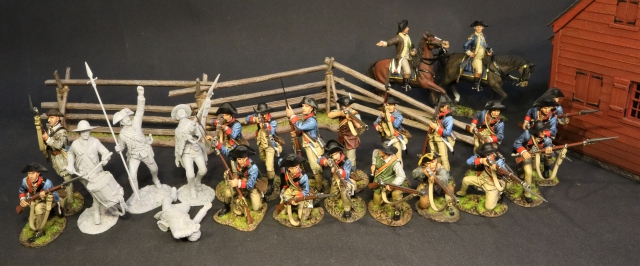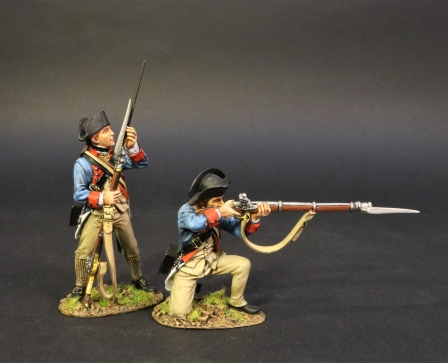
THE EIGHTEENTH CENTURY COLLECTION
DRUMS ALONG THE MOHAWK
SNH-07
The Battle of Saratoga 1777, Continental Army,
The 2nd New Hampshire Regiment,
2 Line Infantry
(2pcs) US$80
Please note that the New Hampshire Regiment figures will be re-paints of the previous Continental Figures.
"The surrender that changed the world".
In October 1777, a 6,000 strong British army surrendered in defeat after the American victory at the Battles of Saratoga.
For the first time in history a British General surrendered his sword.
Burgoyne's strategy to divide New England from the southern colonies
had started well but slowed due to logistical problems.
He won a small tactical victory over General Horatio Gates and the Continental Army
in the September 19 Battle of Freeman's Farm at the cost of significant casualties.
The First Battle of Sartoga 1777
The Battle of Freeman's Farm, September 19th 1777
The Continental Army
The Continental Army was formed by the Second Continental Congress
after the outbreak of the American Revolutionary War by the colonies
that became the United States of America.
Established by a resolution of the Congress on June 14, 1775,
it was created to coordinate the military efforts
of the Thirteen Colonies in their revolt against the rule of Great Britain.
The Continental Army was supplemented by local militias and troops
that remained under control of the individual states or
were otherwise independent.
General George Washington was the commander-in-chief of the army throughout the war.
The Continental Army consisted of soldiers from all 13 colonies and,
after 1776, from all 13 states.
When the American Revolutionary War began at the Battles
of Lexington and Concord on April 19,
1775, the colonial revolutionaries did not have an army.
Previously, each colony had relied upon the militia,
made up of part-time citizen-soldiers,
for local defense,
or the raising of temporary "provincial regiments" during specific crises
such as the French and Indian War of 1754-63.
As tensions with Great Britain increased in the years leading to the war,
colonists began to reform their militias in preparation for the perceived potential conflict.
Training of militiamen increased after the passage of the Intolerable Acts in 1774. Colonists such as Richard Henry Lee proposed
forming a national militia force,
but the First Continental Congress rejected the idea.
The Continental Army of 1777-80 evolved out of several critical
reforms and political decisions that came about
when it became apparent that the British were sending massive
forces to put an end to the American Revolution.
The Continental Congress passed the "Eighty-eight Battalion Resolve",
ordering each state to contribute one-battalion
regiments in proportion to their population,
and Washington subsequently received authority to raise an additional 16 battalions.
Enlistment terms extended to three years or to "the length of the war"
to avoid the year-end crises that depleted forces
(including the notable near-collapse of the army at the end of 1776,
which could have ended the war in a Continental,
or American, loss by forfeit).
The 2nd New Hamphshire Regiment
The 2nd New Hampshire Regiment was formed in early May 1775,
as the second of three Continental Army regiments raised by
the state of New Hampshire during the American Revolutionary War.
Its first commander was, Colonel Enoch Poor,
with Joseph Cilley as major.
Many of the men who served in the unit hailed from southeastern New Hampshire and western, Maine (then part of Massachusetts).
After Enoch Poor was promoted to Brigadier,
Nathan Hale was commissioned colonel of the 2nd New Hampshire Regiment in April 1777.
Flags or colors which belonged to the 2nd NH were captured
at Fort Anne in July 1777 during the retreat from Fort Ticonderoga.
After more than a century, they were returned from Britain,
and are on display today at the Tuck Library of the New Hampshire Historical Society in Concord.
They are among the only American battle flags from the Revolutionary War known to exist.
The colors containing the motto "The Glory Not the Prey" are marked "2nd NH Regt",
while the other colors captured at the time,
the linked 13 rings,were likely a type of national color.
Two other flags captured by the British at Skenesboro were also noted and they had similar designs,
especially another with the 13 linked rings.
While their colors were lost,
the 2nd New Hampshire fought bravely in the autumn of 1777,
where they were heavily engaged with British forces at Saratoga,
leading to the surrender of General John Burgoyne's army.

We now accept PAYPAL,
to purchase your figures please send your order by e-mail to
inquiry@johnjenkinsdesigns.com
after checking that everything is available,
you will be billed via PAYPAL.
your order will be shipped on confirmation of payment.
worldwide airmail 15%
(minimum postage us$15)
JOHN JENKINS DESIGNS
UNIT 6E, TOWER 2,
KING LEY INDUSTRIAL BUILDING,
33-35 YIP KAN STREET,
WONG CHUK HANG,
HONG KONG
Tel: 852 9041 9065
